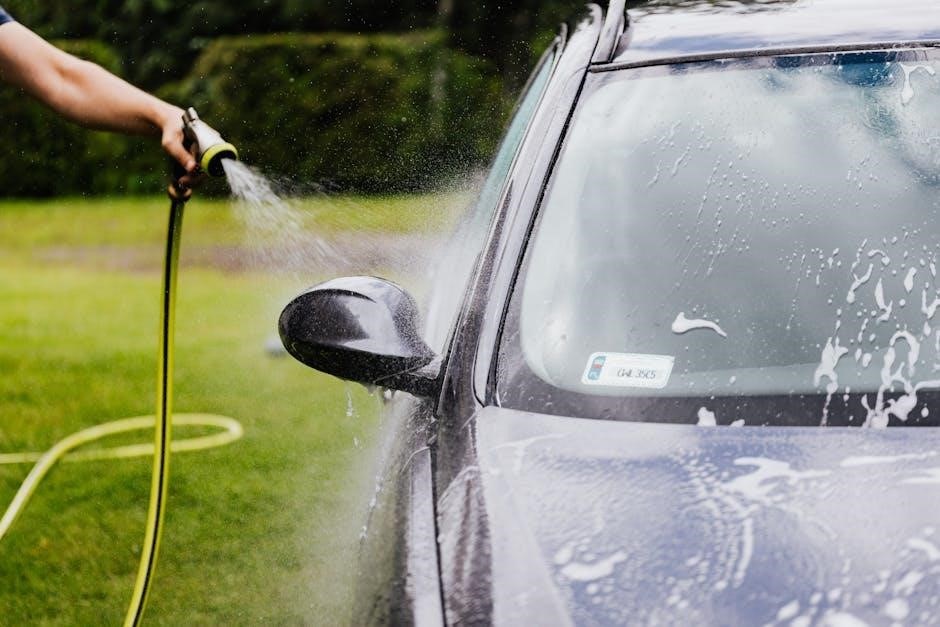
-
By:
- terrence
- No comment
cessna 152 maintenance manual pdf
The Cessna 152 Maintenance Manual provides essential guidelines for the proper upkeep of the aircraft, ensuring safety and performance. It covers airframe, engine, and system maintenance, offering detailed procedures for inspections, repairs, and compliance with FAA standards. Regular updates and service bulletins are included to address emerging issues and improve reliability. Adhering to this manual is crucial for maintaining airworthiness and extending the aircraft’s service life.
1.1 Overview of the Cessna 152 Aircraft
The Cessna 152 is a two-seat, single-engine aircraft widely used for flight training and personal flying. Known for its reliability and fuel efficiency, it features a robust airframe and a 110-horsepower Lycoming O-235 engine. The aircraft is equipped with a fixed tricycle landing gear and a simple, durable design, making it ideal for novice pilots. Its performance characteristics include a cruise speed of approximately 110 knots and a service ceiling of 14,000 feet. The Cessna 152 is popular globally, with numerous models covered in the maintenance manual, ensuring comprehensive guidance for upkeep and troubleshooting.
1.2 Purpose of the Maintenance Manual
The Cessna 152 Maintenance Manual is designed to ensure the aircraft’s airworthiness, safety, and optimal performance. It provides detailed instructions for routine inspections, repairs, and replacements, adhering to FAA standards. The manual serves as a comprehensive guide for owners, mechanics, and pilots, outlining procedures to prevent breakdowns and maintain operational integrity. It includes schedules for inspections, troubleshooting techniques, and compliance requirements, ensuring the aircraft remains safe and reliable for flight operations. Regular updates and service bulletins are incorporated to address emerging issues and enhance maintenance practices.
1.3 Importance of Regular Maintenance
Regular maintenance is crucial for ensuring the Cessna 152’s airworthiness, safety, and performance. It prevents mechanical failures, extends the aircraft’s lifespan, and maintains compliance with FAA regulations. Proper upkeep reduces the risk of accidents, ensures reliable engine operation, and safeguards avionics functionality. Neglecting maintenance can lead to costly repairs, grounded aircraft, and potential safety hazards. Adhering to the manual’s schedules and guidelines ensures the aircraft remains in optimal condition, protecting both passengers and the investment in the plane. Consistent maintenance also supports long-term operational efficiency and flight readiness.

Key Sections of the Cessna 152 Maintenance Manual
This manual is divided into essential chapters covering airframe, engine, avionics, hydraulic systems, and propeller maintenance, providing detailed procedures for each component to ensure optimal performance and safety.
2.1 Chapter 1: Airframe Maintenance
Chapter 1 focuses on the inspection and maintenance of the Cessna 152 airframe, including structural components, skin, and control surfaces. It outlines procedures for detecting wear, corrosion, and damage, ensuring the integrity of the aircraft. Regular cleaning, lubrication, and replacement of worn parts are emphasized to maintain safety and performance. Additionally, this chapter provides guidelines for repairing dents, rivets, and other structural damages, adhering to FAA standards. Proper documentation of all maintenance activities is also highlighted to ensure compliance and traceability. This section is critical for preserving the aircraft’s airworthiness and longevity.
2.2 Chapter 2: Engine Maintenance
Chapter 2 details the maintenance procedures for the Cessna 152’s Lycoming O-235 engine. It covers routine inspections, compression checks, and oil analysis to ensure optimal performance. Guidelines for fuel system maintenance, including fuel filter replacement and fuel line inspections, are provided. Additionally, the chapter addresses cylinder and piston maintenance, timing gear inspections, and spark plug replacement. Proper lubrication schedules and cooling system checks are emphasized to prevent overheating and extend engine life. Compliance with FAA standards ensures reliability and safety during operation.
2.3 Chapter 3: Avionics and Electrical Systems
Chapter 3 focuses on maintaining the Cessna 152’s avionics and electrical systems. It outlines procedures for inspecting and testing communication and navigation equipment, including transponders and GPS systems. The section also covers electrical circuit diagnostics, battery maintenance, and wiring inspections. Guidelines for troubleshooting common issues like faulty avionics displays or electrical malfunctions are provided. Proper grounding techniques and safety protocols are emphasized to prevent system failures. Regular updates to avionics software and compliance with FAA standards ensure reliable performance and safety in flight operations.
2.4 Chapter 4: Hydraulic and Landing Gear Systems
Chapter 4 covers the maintenance of the Cessna 152’s hydraulic and landing gear systems. It provides detailed procedures for inspecting and servicing hydraulic components, such as fluid levels, lines, and actuators. The section also addresses landing gear lubrication, tire condition checks, and brake system maintenance. Guidelines for testing hydraulic pressure and ensuring proper landing gear alignment are included. Additionally, procedures for handling emergencies like gear malfunctions are outlined, emphasizing safety and adherence to manufacturer specifications to ensure reliable ground and flight operations.
2.5 Chapter 5: Propeller and Control Surfaces
Chapter 5 focuses on the maintenance of the Cessna 152’s propeller and control surfaces. It outlines procedures for inspecting propeller blades, checking blade angles, and ensuring secure attachment. Guidelines for balancing the propeller and addressing vibration issues are provided. The section also covers inspection and maintenance of ailerons, elevators, and rudder, including hinge and linkage checks. Instructions for repairing or replacing damaged surfaces and ensuring proper alignment are emphasized to maintain optimal flight performance and control.

Safety Precautions and Guidelines
Adhere to safety protocols, including wearing protective gear, securing aircraft, and following manual instructions. Use proper tools and maintain awareness to prevent accidents during maintenance.
3.1 General Safety Practices
Always wear protective gear, including safety glasses and gloves, when performing maintenance. Ensure the aircraft is securely tied down and powered off. Use approved tools and follow proper lifting techniques to prevent injury. Familiarize yourself with emergency procedures and maintain a clean workspace to reduce hazards. Regularly inspect equipment and report any damage. Adhere to all safety guidelines outlined in the Cessna 152 maintenance manual to ensure personal and aircraft safety during all procedures.
3.2 Handling Hazardous Materials
When handling hazardous materials during Cessna 152 maintenance, always follow the guidelines in the maintenance manual. Wear appropriate PPE, including gloves and eye protection, to prevent exposure. Ensure proper ventilation in the work area to avoid inhalation of fumes. Store hazardous materials in approved containers and dispose of them according to environmental regulations. Refer to the material safety data sheets (MSDS) for specific handling instructions. Never mix chemicals unless explicitly instructed, and keep firefighting equipment nearby in case of emergencies.
3;3 Safety Equipment and Tools
Essential safety equipment and tools are critical for Cessna 152 maintenance. Always use safety glasses, gloves, and a fire extinguisher nearby. A first aid kit should be readily accessible. Utilize jack stands and chocks to secure the aircraft during inspections. Ensure all tools are in good condition and properly calibrated. Regularly inspect and maintain safety equipment to guarantee reliability. Keep a multitool and flashlight handy for convenience. Adhere to the manual’s recommendations for specific tools and equipment to ensure safe and effective maintenance practices.

Compliance and Regulatory Requirements
Adherence to FAA regulations and aviation standards ensures safety and airworthiness. Proper documentation and compliance with legal obligations are essential for maintaining operational integrity and avoiding penalties.
4.1 FAA Regulations and Standards
The Cessna 152 maintenance manual must comply with Federal Aviation Regulations (FARs) and standards set by the FAA. These regulations ensure the aircraft’s airworthiness and safety. Specific guidelines cover design, performance, and operational limits. Maintenance tasks must adhere to FAR Part 23, which applies to small aircraft. The manual aligns with these standards, providing detailed procedures for inspections, repairs, and modifications. Compliance is critical to avoid penalties and ensure the aircraft remains safe for flight; Referencing the FAA’s official documentation is essential for accurate adherence to these requirements.
4.2 Required Documentation and Logs
Proper documentation is crucial for maintaining the Cessna 152. The maintenance manual requires keeping detailed aircraft logs and engine logs to track all maintenance activities. These records include inspection dates, repairs, and compliance with FAA standards. Additionally, modification records and service bulletins must be documented. Accurate logging ensures compliance with airworthiness requirements and provides a clear history for regulatory inspections. Maintainers must follow the manual’s guidelines for recording and storing these documents securely.
4.3 Service Bulletins and Airworthiness Directives
Service bulletins and airworthiness directives are critical for ensuring the Cessna 152’s safety and compliance. Service bulletins provide recommendations for inspections, modifications, or repairs, while airworthiness directives are mandatory and address safety-critical issues. The maintenance manual requires strict adherence to these directives to maintain the aircraft’s airworthiness. Non-compliance with airworthiness directives can render the aircraft unairworthy. These documents are regularly updated and must be referenced from official Cessna or FAA sources to ensure compliance with the latest standards and regulations.

Troubleshooting Common Issues
Troubleshooting involves identifying symptoms, isolating faults, and applying corrective actions. Utilize diagnostic tools and maintenance manual guidelines to ensure accurate and safe issue resolution.
5.1 Identifying and Diagnosing Problems
Identifying issues begins with thorough inspections and review of maintenance logs. Use diagnostic tools to pinpoint faults, such as unusual noises or performance deviations. Visual checks, like looking for wear or damage, are critical. Systematic troubleshooting involves isolating components and testing functionality. Always refer to the Cessna 152 maintenance manual for specific diagnostic procedures and guidelines. Early detection prevents minor issues from escalating, ensuring safety and reliability. Effective diagnostics require a combination of experience and adherence to manual protocols.
5.2 Common Maintenance Challenges
Common maintenance challenges for the Cessna 152 include corrosion, particularly in coastal environments, and wear on aging engine and avionics systems. Limited availability of certain parts can delay repairs, while ensuring compliance with FAA regulations remains critical. Regular, thorough inspections are vital to identify and address these issues early. However, unexpected problems still arise, necessitating swift and accurate solutions. Adhering to the maintenance manual and maintaining precise documentation are essential to effectively managing these challenges and ensuring continued airworthiness.
5.3 Solutions and Repair Techniques
Solutions for Cessna 152 maintenance often involve detailed inspection, cleaning, and replacement of worn components. Corrosion can be addressed with specialized treatments and coatings. Engine issues may require rebuilding or replacing parts, while avionics problems can be resolved by upgrading or recalibrating systems. Proper tool usage and adherence to FAA standards are essential. Regular lubrication of moving parts and timely replacement of seals and gaskets prevent leaks. Detailed documentation ensures repairs are tracked and compliant with airworthiness requirements, maintaining safety and performance.

Maintenance Schedules and Intervals
Routine inspections, annual checks, and 100-hour inspections ensure compliance and safety. Pre-flight, daily, and periodic tasks maintain airworthiness, optimizing performance and preventing unexpected issues.
6.1 Routine Inspection Checklists
Routine inspections are essential for maintaining the Cessna 152’s airworthiness. These checklists include pre-flight, daily, and periodic inspections, ensuring all systems function correctly. Tasks involve checking fuel, oil, tires, brakes, and control surfaces. Specific intervals, such as the 50-hour inspection for engine oil and filter changes, and the annual inspection for detailed airframe and engine checks, are outlined. Compliance with these schedules ensures safety, prevents issues, and aligns with FAA regulations. Proper documentation of each inspection is mandatory for legal and maintenance tracking purposes.
6.2 Scheduled Maintenance Tasks
Scheduled maintenance tasks for the Cessna 152 are organized into specific intervals to ensure reliability and safety. These tasks include oil changes every 50 hours, spark plug replacements at 100 hours, and tire rotations at 200 hours. Additionally, annual inspections involve detailed checks of the airframe, engine, and systems. Compliance with these schedules ensures adherence to FAA regulations and prevents potential failures. Proper documentation of completed tasks is required to maintain airworthiness certification and provide a clear maintenance history for the aircraft.
6.3 Unscheduled Maintenance Procedures
Unscheduled maintenance procedures address unexpected issues or discrepancies found during routine operations. These may include system malfunctions, damage from foreign objects, or post-flight damage assessments. Immediate action is required to ensure safety, often involving grounding the aircraft until repairs are made. The Cessna 152 maintenance manual provides specific procedures for such scenarios, emphasizing adherence to manufacturer guidelines. Proper documentation of unscheduled maintenance is critical for tracking and ensuring compliance with airworthiness standards.

Tools and Equipment Required
Essential tools include wrenches, pliers, screwdrivers, and multimeters. Specialized equipment like rivet guns and avionics testers are necessary. Safety tools such as fire extinguishers are also required.
7.1 Essential Tools for Cessna 152 Maintenance
The Cessna 152 requires basic hand tools like wrenches, screwdrivers, and pliers for routine maintenance. A torque wrench is essential for bolt tightening. Socket sets and hex keys are needed for specific bolts. Pneumatic tools, such as impact wrenches, can streamline tasks. A multimeter is crucial for electrical diagnostics. Safety tools, including safety glasses and a fire extinguisher, are mandatory. Proper tool usage ensures compliance with Cessna 152 maintenance manual pdf guidelines. Always use tools that meet aviation standards for safety and reliability.
7.2 Specialized Equipment and Instruments
Specialized equipment for Cessna 152 maintenance includes avionics testers, hydraulic pressure gauges, and fuel flow meters. These tools ensure precise measurements and diagnostics. Compression testers are used for engine health checks, while oxygen system testers verify the aircraft’s oxygen delivery. Calibration tools are essential for maintaining accuracy; These instruments are critical for performing advanced diagnostics and repairs, ensuring compliance with Cessna 152 maintenance manual pdf standards. Proper use of specialized tools guarantees the aircraft’s airworthiness and optimal performance.
7.3 Calibration and Tool Maintenance
Calibration and tool maintenance are vital for ensuring accuracy and reliability in Cessna 152 maintenance. Tools like torque wrenches and multimeters must be calibrated periodically to meet FAA standards. Regular inspection of tools for wear or damage is essential, and storage in designated areas prevents loss or misuse. Lubrication of movable parts and replacement of worn components are also critical. Proper calibration and maintenance ensure tools remain precise, supporting safe and efficient aircraft servicing as outlined in the Cessna 152 maintenance manual pdf.

Training and Certification
This section emphasizes the importance of proper training and certification for Cessna 152 maintenance personnel, ensuring compliance with FAA standards and safe aircraft servicing.
8.1 Required Training for Maintenance Personnel
Proper training is essential for Cessna 152 maintenance personnel to ensure safety and compliance with FAA regulations. Training programs typically include theoretical knowledge and hands-on experience. Personnel must understand aircraft systems, tools, and procedures. The curriculum covers airframe, engine, and avionics maintenance, as well as safety protocols. Many programs incorporate the Cessna 152 Maintenance Manual for detailed guidance. Recurrent training is mandatory to stay updated on new techniques and regulatory changes, ensuring competence and adherence to industry standards.
8.2 Certification Processes and Renewal
Certification for Cessna 152 maintenance personnel involves completing FAA-approved training programs and passing rigorous exams. Technicians must demonstrate proficiency in aircraft maintenance, repairs, and inspections. Certification renewal occurs every 5 years, requiring continued education and adherence to FAA standards. Renewal ensures technicians stay updated on the latest maintenance practices and regulatory changes. Proper documentation and compliance with certification processes are critical to maintaining airworthiness and safety standards for the Cessna 152 aircraft.
8.3 Continuous Professional Development

Continuous professional development is essential for maintaining expertise in Cessna 152 maintenance. Technicians should engage in ongoing training, workshops, and seminars to stay updated on advancements in aviation technology and regulatory changes. Regular participation in industry events and manufacturer-specific training programs ensures proficiency. Additionally, technicians benefit from practical hands-on sessions and access to updated maintenance manuals. Continuous learning fosters a culture of safety, efficiency, and compliance, ensuring optimal performance in maintaining the Cessna 152 aircraft.

Resources and References
The Cessna 152 maintenance manual PDF provides access to official documentation, manufacturer guides, and training materials. Online forums and communities also offer valuable insights and support.
9.1 Official Cessna Documentation and Manuals
The Cessna 152 maintenance manual PDF is an essential resource for aircraft maintenance, providing detailed procedures, specifications, and guidelines; Official Cessna documentation includes the Aircraft Maintenance Manual (AMM), Illustrated Parts Catalog (IPC), and Service Bulletins. These manuals are critical for ensuring compliance with manufacturer standards and regulatory requirements. They cover airframe, engine, avionics, and system-specific instructions, enabling technicians to perform accurate and safe maintenance. Accessing these documents through authorized Cessna channels or approved aviation organizations ensures reliability and adherence to best practices.
9.2 Online Forums and Communities
Online forums and communities provide valuable insights and support for Cessna 152 maintenance. Platforms like Reddit’s r/aviation, AOPA forums, and specialized aviation maintenance groups offer spaces for technicians to discuss challenges, share experiences, and access resources. These communities often include discussions about the Cessna 152 maintenance manual PDF, with members sharing tips on troubleshooting and best practices. Engaging with these forums can enhance knowledge and provide peer support, ensuring maintenance tasks are performed effectively while fostering collaboration among aviation professionals.
9.3 Training Materials and Guides
Training materials and guides complement the Cessna 152 maintenance manual PDF by offering detailed instruction for technicians. Official Cessna guides provide step-by-step procedures, while third-party resources include interactive tutorials and video demonstrations. Workshops and online courses cover specialized topics like avionics troubleshooting and engine overhaul. These tools ensure that maintenance personnel acquire the skills needed to perform tasks safely and efficiently, adhering to industry standards. Regular updates to these materials keep technicians informed about the latest maintenance practices and advancements in aircraft care.